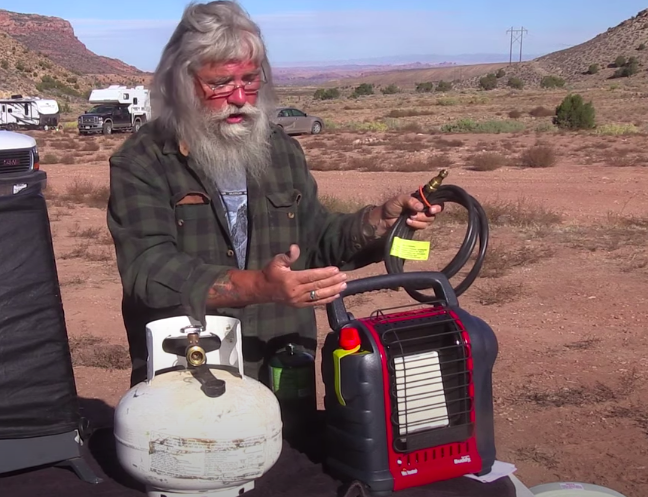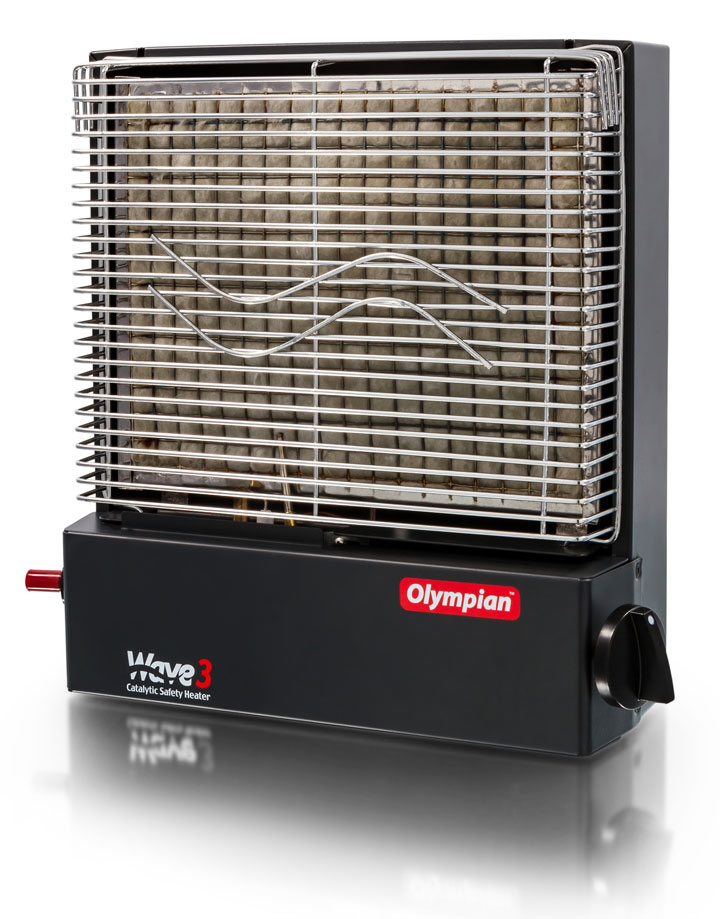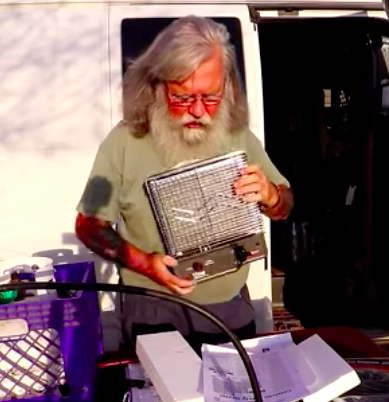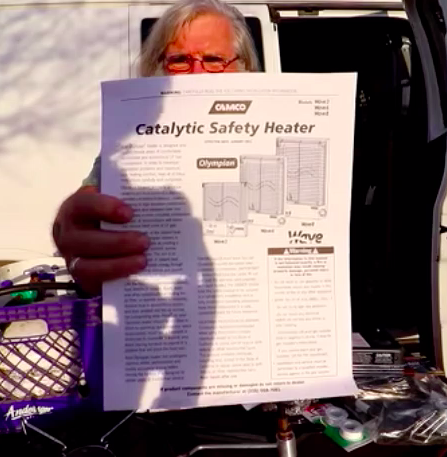
Nomadic living is miserable when we’re cold. This mobile lifestyle isn’t about testing how much suffering we can withstand. So if you’re going to be in a cold climate, if there are reasons you can’t migrate to milder weather, then a good, effective, reliable heater is an absolute necessity.
You can still find videos of me offering the Mr. Heater Buddy as a solution to heating your rig. But I’ve stopped doing that. Why?
First, it’s too hot, even on the low setting. If you have any insulation at all a van will be too hot to bear in only a few minutes.
The second reason is the space requirements around the heater to prevent setting something on fire: 30” above, 24” in front, 6” on each side. You might not have that much open space in your rig.
The third reason is expense. The Buddy is $80-100 for a single-purpose appliance you’d use only part of the year. Meanwhile, a one-burner stove is almost half that price. Here’s an article about heating with a stove.
The fourth reason is unreliability. I get so many letters about Portable Buddy heaters failing. It’s such a problem that Mr. Heater sells repair kits, but they don’t always solve the problem.
If you connect your Portable Buddy to a bulk propane tank you need a filter between the hose and the heater. Propane leeches a substance from the hose that clogs the heater internals. The filter catches it and must be replaced each season.
Finally, the low-oxygen sensor in Mr. Heater products shuts off the heater at elevations above 7,000 feet. That might sound high to the Mr. Heater folks in Cleveland, but it’s too low for those of us who spend time in the mountains.
Yes, some people are perfectly happy with their Mr. Heater Buddy, and that’s good. But there are other options.
WHAT I DO RECOMMEND
Since I no longer recommend the Mr. Heater Portable Buddy, which propane heater do I suggest instead? The Camco Olympian Wave 3 catalytic heater.
The Wave 3 costs more than a Buddy, but it will last much longer.

WHAT IS A CATALYTIC HEATER?
Rather than creating heat with a flame, a catalytic heater uses a chemical reaction between oxygen in the air, propane fuel, and a platinum-impregnated mat. (Platinum is one reason these heaters cost more.) The reaction creates a fancy thing called far-infrared wave emitters that produce radiant heat.
Olympian explains, “Like the sun, Olympian heaters radiate heat directly to people, floors, walls and other objects without heating the air first, so warmth is felt immediately. Radiant heat is absorbed by objects and then emitted into the air to heat the surrounding area.”
Catalytic heating also has significantly higher thermal efficiency than conventional methods.
Olympian continues, “The operational surface temperature of the catalytic heating element is 720°F maximum, well below the temperature of conventional flame type heaters, which operate at 2,100°F. For this reason, catalytic heaters are considerably safer than conventional flame type heaters.”

LESS IS MORE
The Wave 3 produces 1,600 BTUs on the low setting and 3,000 BTUs on high. The Buddy produces 4,000 BTUs on low and 9,000 BTUs on high. Yes, the Wave 3 puts out less heat, but that’s a good thing, because the Buddy is too hot for something the size of a van. You’ll find yourself turning a Buddy on and off, on and off to keep within a comfortable temperature range. Meanwhile, the Wave 3’s lower output is, as Goldilocks would say, j-u-u-u-s-t right. I lived in a box truck in Alaska for six years where it was routinely 30 below zero in the winter. The Wave 3 that I used was ideal.
NOTHING’S PERFECT. WHAT’S THE CATCH?
Besides the higher price of the unit, you’ll also need to buy a hose with a pressure regulator. Depending on where you want to locate the heater, you might need an elbow coupling. You’ll need a Y coupler if you want to connect a stove to the same propane tank at the same time. Olympian heaters are meant to be wall mounted. If you want to stand them on the floor you’ll need to buy the optional feet (more cost) or fabricate some yourself. Also, it’s essential to keep the heater covered whenever it’s not in use (after it has cooled down, of course). Otherwise dust and other airborne stuff will clog the catalyst mat over time, reducing or even destroying its functionality. You can buy the pricey cover Olympian sells, or you can do as some owners and use an appropriately sized elastic bowl cover.

DO NOT KILL YOURSELF
Propane heaters are safe when used according to the manufacturer’s instructions. So the very first thing to do, before setting up the heater, before connecting it to the propane tank, is to read the instructions carefully and completely. More than once. Then do exactly as it says. In fact, you can read the instructions online here before you even buy the heater. If the care and feeding of a Wave 3, and the steps to protect your safety, seem like too much for you to handle, then choose some other way to keep warm. But, really, it’s not that hard if a non-genius like me can do it.
Even if you don’t get a propane heater, stay warm and stay happy my fellow nomads.

Excellent article. Very easy to read.
I’m tenting with a Buddy and it’s up down all night hot/cold. I’m anxious to try the “new Wave”
I have used and enjoyed both types of heaters.
> The Wave 3 costs more than a Buddy, but it will last much longer.
Might want to check on the replacement schedule for the catalytic element, and that it can be damaged by touching or cleaning it.
And while we are reading the manual, folks living in the dusty West will want to know “the heater and its surroundings should be kept clean and free of dust. • It is recommended that the heater be kept covered at all times when not in use:”
> Buddy produces 4,000 BTUs on low and 9,000 BTUs on high.
The Buddy can be run /below/ the low setting while maintaining a clean blue flame. It can even be run on just the pilot light.
Having said all that, I rarely use the Buddy. Following mild weather and cooking inside the insulated camper is typically all I need. At night I sleep on a ~13w heated mattress pad.
I install the Olympian Wave 8 in a shack I use for an office and am very happy with it. Even on high it is very fuel efficient.
Would the WAVE produce as much water vapor
I could only guess. Since it’s producing fewer BTUs of heat, perhaps that means it’s combusting less propane and therefore less water vapor. Maybe someone else has a more authoritative answer.
You’re on the right track. Combustion and catalysis produce the same amount of water vapor. If less propane is used to heat a given area (by whatever mechanism) less water vapor will be produced.
People fighting interior humidity might consider an exterior-vented heater (Chinese diesel heater or whatever).
100 % agree with Bob. Catalytic heaters are not new technology. They are time tested. My parents retired to the RV life in the early 1990’s. They lived 1/2 the year in a SKP park in Benson AZ. After my dad died my mom lived in a park model & kept it well heated with 1 catalytic heater during the winters there which could cold in the teens.
Curious – does the WAVE create a similar amount of moisture?
Sorry for the double question – didn’t realize there had been a response..
Thank you @Al Christensen and @secessuss
Such good information Bob. Also, good comments, questions and answers. So helpful as I try to gather information about what would work best for me.
2003, we converted a 1996 Ford CF8000 commercial truck to our concept of an ExpeditionVehicle.
Our interior is 7w x 12 l x 7h, about 700cf.
For insulation, we mounted adhesive-back acoustic insulation against the outer wall.
A gap, then one-inch pink-board.
Another air-gap, then two-inch foil-side poly on the inner.
Our floor is one-inch pink-board, topped with half-inch marine plywood painted on all surfaces to seal.
Our visual floor is bamboo plank surrounding slate in the center.
Nearly two decades full-time live-aboard, the floor pink-board shows zero-zero-zero signs of compression.
.
Our windows are 3612, three feet wide by a foot tall, dual-pane sliders designed for a stand-still house.
I mounted these at our eye-level standing inside, about eight feet above pavement.
.
Nearly two decades full-time live-aboard, our heater is an ancient Wave 3 catalytic.
The directions warn about contamination of the element, but our experiences refute that.
.
With our insulation, with three RedHeelers plus two adults (and a frequent yummy third!), we only turn on the heater after the outside temperature dips below 40°f (metrifical equivalent 657.3 hectares-per-milihour).
.
On the LOW setting of 1,700Btu, the Wave 3 needs three windows open to vent some heat… taking humidity with it.
Nearly two decades full-time live-aboard, and we have zero-zero-zero issue with condensation.
.
An aside:
* We built our bed platform with expanded metal, similar in appearance to stout window-screen, for plenty of circulation under the mattress.
* We have zero-zero-zero closed cabinets, preferring milkcrate-style crates for their openness.
.
Finally, our home-built avoids a major source of water incursion in factory RecreateVehicles — Holes! In! The! Roof!.
Thanks for the up-dated recommendation. I’ve got a list going of things I want &/or need to getonce I’m able to start my vandwelling adventure. Now I’ll be able to cross off the Mr Buddy anf replace it with this.